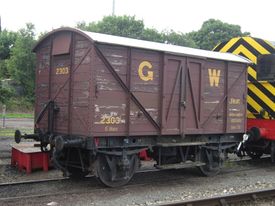GWR 2303 Fruit Van
| GWR 2303 Fruit Van | |
|---|---|
 GWR 2303 Fruit Van | |
| Built By | GWR Swindon |
| Status | Operational |
| Number | 2303 |
| Other Numbers | 47833, DW 150063 |
| History | |
| Built | 1898 |
| Diagram | Y2 |
| Lot | 230 |
| Type | 4-w ventilated van |
| Capacity | 6 tons |
| Telegraphic code | FRUIT |
| Brakes | Vacuum-braked |
| 1973 | Entered preservation on the SVR |
| 1988 | Restoration completed |
| 2019 | Overhauled |
Contents
Contents
Service
The GWR began the construction of ventilated vans specifically for carrying fruit in 1890, and these were categorised under Diagram Y. 2303 was built at Swindon in 1898 to Diagram Y2 as part of Lot 230 and was originally numbered 47833 in the Goods series. It had a 6-ton capacity with a 10ft wheelbase. The ventilation on Y2 vans included gaps between the floor planks open to the track, as well as single louvres between the planks and central end vents. The majority of the Y2 vans including 2303 were built as vacuum braked only and given the telegraphic code FRUIT, although the last 22 included dual brakes and were coded FRUIT A.[2][3]
47833 was later renumbered 2303 in 'Brown Vehicle' series from 1916 until withdrawal in 1958. It was then converted to a Packing Van and numbered DW 150063 in Departmental use. It was withdrawn for scrapping from BR Tyseley in 1973.[4]
Preservation
2303 was acquired by The GWR 813 Preservation Fund, being delivered to Bewdley on 24 November 1973.[1][5] It spent a period in use as a stores van for the Gresley Coach Fund.[6] Some restoration work began in Autumn 1983;[7] by spring 1984 all the roof timbers had been replaced and the body was being cleaned down and repainted.[8] Further work was then postponed awaiting heavier repairs, which began when the van became the Wagon Department’s project for Winter 1987.[9] The work carried out included overhauling the van’s mechanics and replacing corroded steel T-sections and rotten tongue and groove boards. New doors were built, the roof re-canvassed and the van repainted in GWR ‘Brown’ livery. 2303 returned to service in mid-1988, although a planned appearance in the 1988 June Freight Weekend parcels train was ended by a 'hot box' due to a broken spring in the bearing lubricating pad.[6]
2303 received a further repaint in 1993.[10] From Summer 2018 it underwent overhaul and a repaint at Bewdley Goods Shed by the Wagon Department, completed in February 2019.[11]
It is owned by the GWR 813 Preservation Fund.